Having an incorrect lie angle on your golf club can have a huge impact on your ability to hit the ball straight.
If your lie angle is too flat, you will tend to slice the ball. If your lie angle is too upright, then you will tend to hook the ball.
It can even cause you to develop swing compensations to correct for it, preventing you from ever developing a consistent, repeatable, and powerful swing.
Knowing what the difference is between a flat vs. upright lie angle is, how it affects your shot, and how to fix it can take strokes off your game quickly and even set you up to develop a better swing down the road.
So let’s start with what these terms actually mean.
You should also know that golf irons can be adjusted, most of the time and it is a good idea to get them checked periodically.
And if you are just getting started with the sport, go check out our in-depth guide on the Best Golf Clubs For Beginners to learn how to select the right clubs and see our top picks for this year.
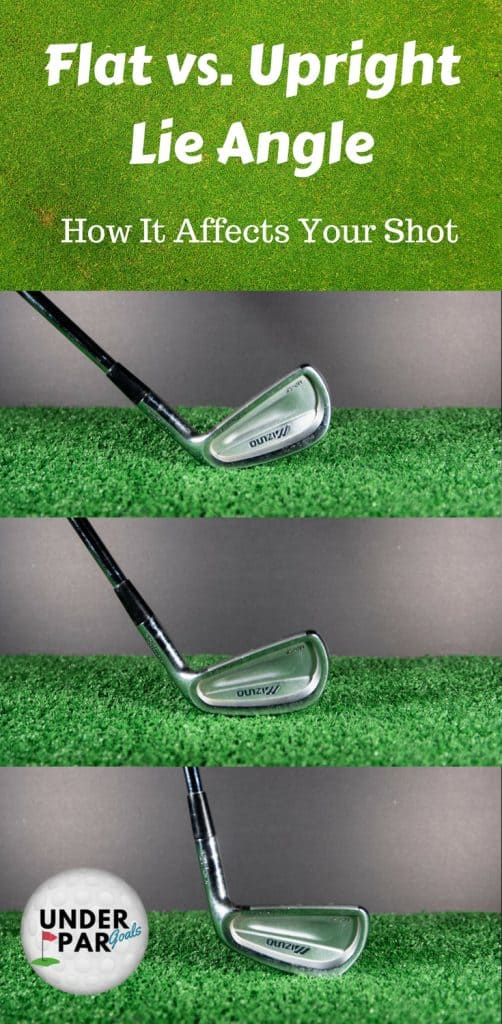
What’s In This Article
- What Is Lie Angle and How Do You Measure Lie Angle
- How To Check Your Lie Angle
- Effect of A Flat vs. Upright Lie Angle On Your Shots
- What Does It Mean To Be Too Upright?
- Adjusting Your Lie Angle
- Using A Lie Angle Adjustment To Help Improve Your Swing
How To Measure Lie Angle On A Golf Club
Lie angle is a measure of the angle that is formed between the shaft of the club and the ground when the club head is in a normal playing position (typically the bottom of the sole is at least slightly rounded.
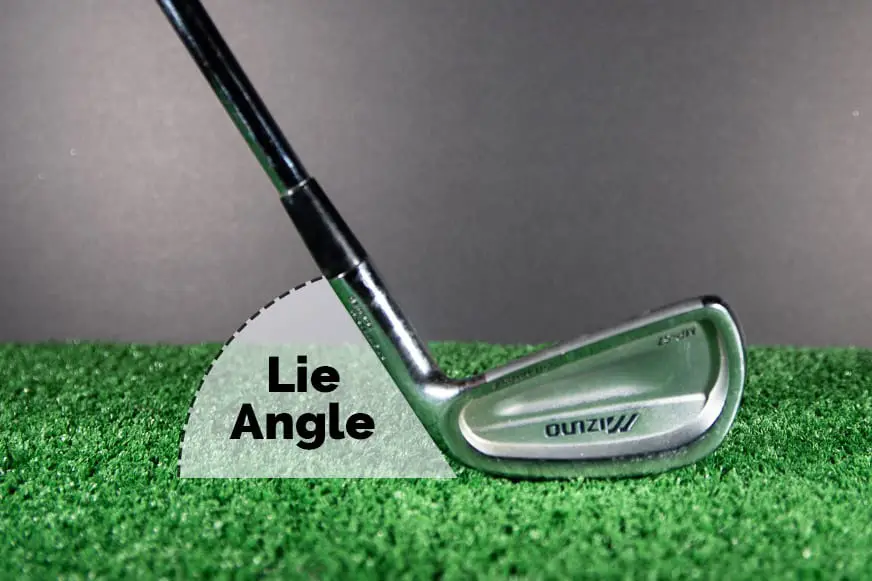
One important piece of this that many golfers miss is that the lie angle that matters is the one at impact when you are swinging. It really doesn’t matter much whether the clubhead is flat when you are just holding it there in your stance.
How To Check Your Lie Angle
The best way to check your lie angle is with a piece of tape and a lie board.
Remember, the lie angle that matters is where the club is when you hit the ball. A lie board will help you figure out if you have a flat vs. upright lie angle when you are taking a real swing and hitting a real ball.
You can pick up a lie board pretty cheap on Amazon like this one.
It is a very simple setup. The tape that is used for this test is white and it usually has a small line in the middle. You can get it on Amazon here.

You place the tape along the sole of the club with the line directly in the middle. You then place the lie board on the ground wherever you can hit a golf ball. That can be at a range, on a course, or just into a net at home. It’s a good idea to do this on a flat level lie so that there are no other factors affecting your swing.
Then you simply place a ball on the lie board and hit it. After hitting the ball, look at the tape on the bottom of your club. Assuming you put the tape in the right place, there should be a small black mark on the tape. If the mark is right on the center line then you have the right lie angle for your swing.
Another way to check your lie angle if you don’t have the tape and a lie board is to bring a sharpie to the driving range. Draw a straight line with the sharpie on one of the balls. There are little inexpensive plastic guides that will help you do this but if you don’t have one of them you can take a scorecard and line it up around the ball as a guide.
Then place the ball in position to hit (either on the ground or a tee) so that the line you drew is perfectly vertical. This is the part where human error can skew this test a little so be careful. Once the ball is in place, set up normally and hit it.
Effect Of Flat vs. Upright Lie Angle On Your Shots
A flat lie angle means that the angle between the shaft and the ground is smaller, making the club shaft more flat as compared with the ground.
If your club is too flat for your swing then it means that during your swing, the toe of the club will be lower than the heel (normally you want them level at impact). That can result in the ball slicing (curving to the right for a right-handed golfer). There are a few reasons for this. In the case of an iron, it can result in the toe making contact with the turf before the center of the clubface makes contact with the ball. That results in an open clubface at the time of impact.
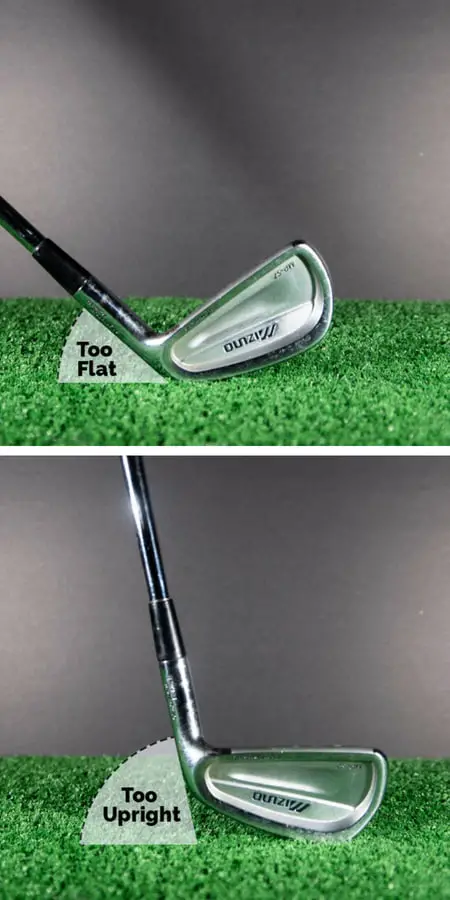
But even if you are hitting off a tee and the club never makes contact with the turf, a lie angle that is too flat will result in a slice.
Why?
Every club has loft, meaning the clubface is angled upwards. When the club is tilted in one direction, that loft, which is normally angled straight up, now becomes tilted to one side or the other. That means that even if you hit the ball with the clubface perfectly square to the target, the tilt (either too flat or too upright) will cause the ball to start angled to one side. It also adds side spin, so not only will your shot start off target, it will spin farther off target. In the case of a lie angle that is too flat, this means a slice.
Since no one wants a ball that slices every time, you will eventually develop a swing that compensates for the incorrect lie angle just so you can try to hit it straight. This compensation means your margin for error is much smaller so you will be less accurate and when you do miss, you won’t be able to predict where the miss will end up. It also means that you are likely not swinging very efficiently and thus costing yourself some swing speed and distance.
An upright lie angle means that the angle between the shaft and the ground is larger than it should be, making the club shaft more upright compared to the ground.
If a club is too upright for your swing this means that during the swing, the heel of the clubhead will be lower than the toe. All the same, problems above will occur, except the ball will hook (curving left for a right-handed golfer).
It is more common to find yourself with a club that has a lie angle that is too upright. That is because most amateur golfers tend to have a swing fault commonly referred to as “swinging over the top” which tends to result in a very upright position at impact. Club manufacturers don’t want to sell clubs that don’t work so when manufacturing clubs for the masses, they make them more upright to compensate for this common affliction.
That doesn’t mean that an upright lie angle at impact is necessarily bad. There are plenty of PGA players that have upright clubs. But generally speaking, most golfers would benefit from clubs that are flatter than the ones off the rack. So keep this in mind when getting fitted.
A great way to see if you tend to hit the ball to one side or another is to track your shots. I use this free stat tracking app on my phone during every round. I still recommend checking your lie angle using the method above because there are other factors that can affect your on-course results. But it is very important to understand what is happening on the course if you do make some lie angle adjustments.
What Does 2 Degrees Upright Mean On A Golf Club?
If a club is 2 degrees upright that can mean a couple of different things depending on the context.
Most likely, it means that a club is 2 degrees more upright than the standard lie angle for that brand and model. For example, if a 5 iron has a standard lie angle of 62 degrees, but you either custom order it or have it adjusted to be a lie angle of 64 degrees, then it would be considered to be 2 degrees upright. So when most people say a club is 2 degrees upright (or 1 degree upright, 2 degrees flat, etc) then they are measuring it off of the standard off the shelf lie measurement for that particular club.
It can also refer to the club being too upright for a particular person. For example, if you went to a club-fitter and your lie angle was measured and it was discovered that the club was too upright for you, then the club fitter may say that it is 2 degrees upright (which means it needs to be adjusted 2 degrees flatter to work for you). In that case, the measurement is based on what is right for you rather than the manufacturer standard.
Both of these are acceptable ways to talk about lie angle, so depending on the circumstances of the conversation, it could mean either of them.
Making A Golf Club Lie Angle Adjustment
This depends a lot on the type of clubs you have.
Some types of clubs cannot be bent once they are manufactured. You have to order them to your specs. This is common among the big chunky game improvement irons. Trying to bend them will either be ineffective or just break the club head. If you are spending the money to invest in new clubs, I’d recommend making sure they can be adjusted.
I’d also recommend getting them adjusted by a professional. Adjusting the lie angle is not like changing the grip on a golf club or even cutting the shaft down. It requires precision tools and measurements and a decent amount of skill to do right. Go find your local club maker to have it done.
Cast vs Forged Clubs For Adjusting Lie Angle
One major consideration you should make when buying irons is whether they are cast or forged.
Cast irons can only be adjusted 1-1.5 degrees at most (some not at all) as far as the lie angle goes. This means that you need to get it right from the start when you buy them. This can be difficult, even if you are custom fit as your swing may change.
Forged clubs are much more adjustable. They can be adjusted 3 or even 4 degrees either flatter or more upright. This means that if your swing changes, you don’t have to go out and buy a new set of clubs.
For better player clubs, it can be easy to find forged clubs, but many game improvement irons are cast. Generally, cast irons are less expensive too. In our guide on the Best Irons For Mid Handicappers, we focused mainly on finding quality forgiving forged irons for this very reason.
But you can also see that in our breakdown of the Best Irons For High Handicappers and Best Irons For Beginners, it was difficult to find forged irons that also fit the player profile.
Bonus Tip: Changing Your Lie Angle To Improve Your Swing
I used to swing way over the top and attack the ball with a very steep shaft angle. So after doing the tests above, I thought I needed a relatively upright lie angle on my clubs. Except that the only reason I needed such a lie angle is because of a swing flaw. After recording my swing on video, it was painfully obvious that I had this huge swing flaw.
So after talking to a swing instructor. I decided to have my clubs bent 2 degrees flat. I’m not that tall so it wasn’t all that extreme for me. At first I could barely hit the ball. Then after a while, my results started to improve. After about a month or so, I recorded another swing. It wasn’t perfect, but my huge over the top move was greatly minimized. I was on my way to a more efficient and consistent swing.
It can be remarkable how the body can adjust and compensate, either positively or negatively. So don’t rely just on testing your lie angle. Get some video, get evaluated by an instructor and make adjustments from there.
Lie angle is one of those things that you never think about but can make a tremendous difference once you get it right.
So before you go investing in a brand new set of game improvement irons to lower your score, check your lie angle first.
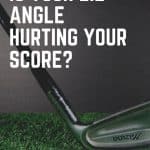
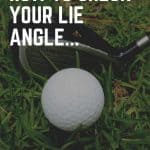
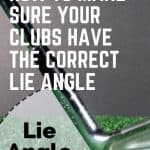
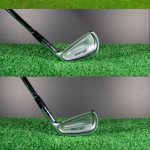
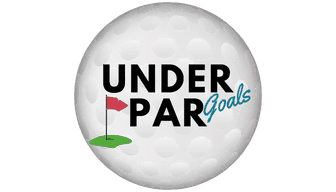
If your club is too flat for your swing then it means the toe of the club is lower than the heel (normally you want them level at impact).
An upright lie angle means that the angle between the shaft and the ground is larger, making the club shaft more upright compared to the ground. This means that the heel of the club head is lower than the toe.
Above is from your article flat vs upright. I always thought flat means that the heel of the club is on the ground. So wouldn’t the toe be high in the sky? Upright would be that the toe of my club is hit the ground and the heel is higher.
When I read the article I upderstood you saying the opposite. Am I just confusing the terms you used?
Tony, you are 100% right. I had a couple typos in there that are now fixed. The general principles are still accurate as are the images. Thanks for picking that up. Lie angle is a tough one to explain in text!
Good article. Do you know if you can get the lie adjusted more than once. I have so a forged set if irons with a 1 degree upright lie angle and want it changed back to flat… thank you
Hey Tony,
Thanks for the compliment. I think it depends on the specific club. Most softer forged metal clubs can be adjusted more than once, and in fact they may need to be checked and re-adjusted on a regular basis (especially if you practice often on turf mats or hard ground). The best way to figure this out is by going to a certified and experienced clubfitter. This is not something that I would recommend anyone try as a DIY project!
Hiya I’ve just read about flat v upright lie
I’m a 10 HC and play with Taylormade M3 irons
I got fitted for the at American golf I was told that I needed a 1degree upright lie on my 3 4 5 6 irons and a 1dg flat on my 9 & PW I’ve been using them for a while but I was hitting my long irons out to the right
To compansate this I turn the head in a little to try and keep them straight but I loose distance
Do I need them adjusted to an upright or a flat lie
It is nearly impossible to diagnose something like that without seeing some video. Only thing I would say is that they may have fitted you for 1 degree upright because you are swinging over the top a bit which causes you to come in steep and cast the club. So the upright clubs are just fitted to a swing fault which can prevent you from fixing the swing fault. That is just speculation because I haven’t seen your swing but it is very common. Seeing an instructor in person would be able to give you a better diagnosis though.
Is there a general sense of proper lie angle depending on height? In other words do taller players tend to need flatter lie angles, etc.? I’m 6’2″ and pull or pull hook all my irons, I couldn’t fade or slice a ball on a bet unless I open it waaay up. On iron shots. I have to weaken both hands and still have to aim right of the target.
Yes, generally speaking, taller players tend to use slightly more upright clubs, but it is not as drastic as you might think. There are a lot of variables in your stance and swing that affect lie angle at impact (dynamic lie angle).
I’ve just gotten back in to golf after about 15 years. Decided I’d get custom fit for irons. During the fitting, I pulled a couple of shots. Used the strikeboard, the gentleman fitting me thought I’d hit better with a more upright lie angle.
Went 2 degrees upright. I’m only 5’10, and the club sat weird at address. My grouping was good, but I still hit a few left. I should have gone for another fitting somewhere else, but ended up buying them.
Now I put everything severely left, and it’s really noticeable in the short irons. I’m not swinging over the top, although I might have been during the fitting. I’ve got Wilson C300s. I hope I can get them fixed.
Yeah that is the danger of getting a fitting based on one visit. A good instructor will be able to identify what your optimal lie angle SHOULD be rather than where it is at that moment. I think those Wilson C300s are forged, which means you can get them bent to a different lie angle. A good clubmaker would be able to tell you for sure.
Excellent article and really makes me think. I have AP2’s and Honmas and I tried to adjust/line up each set to be identical. Honmas adjusted to 1.5* Upright and I can tell when I am tired that I start to swing over the top and forget to turn my hips. I should never tried to adjust the clubs to one another vs. adjust each set to me. I am now going to 1* flat on the honmas. Most importantly, I want to adjust my swing weight. I feel like that is also impacting my swing. Thoughts?
Thanks I am a mother and very busy! This helped me alot!
Is it possible to bend a set of Mizuno JPX 850 cast clubs fro 2 degrees down to 2 degrees up without concern or is that ill advised?
Hi Keith,
Generally, cast clubs break very easily when trying to bend them, so I would not recommend it. But you should look for an experienced club-fitter in your area and ask them about specific make/model clubs.
I am going to buy some PXG clubs online and need some advice as to the the lie angle. I was fit by a professional for my last set of Titleist AP1s and he had me at 2 degrees upright. I was fit a number of years earlier for Titleist 990-Bs and was told the same thing. I believe I would need to add 2 degrees of loft because when I was first fit, I was hitting the ground with the toe and slicing my irons big time.
But after reading your article, I started to think I shouldn’t be that aggressive as all my approach shots now tend to miss left. I have opened the club head and weakened my right grip (right-handed) which will sometimes compensate for the tendency so I am thinking I should only add 1 degree to these clubs. I keep my right elbow tucked close to my hip and have about a 2 degree inside-out swing path so I don’t believe I am a caster. Your thoughts?
Hey Jim, thanks for reading the website. I hate to give this answer, but the only way to diagnose that is to see an instructor. You could also take some slow-mo video of your swing from face-on to see if you are casting. A lot of smartphones can do 120 or even 240 frames per second now which is enough to see that.